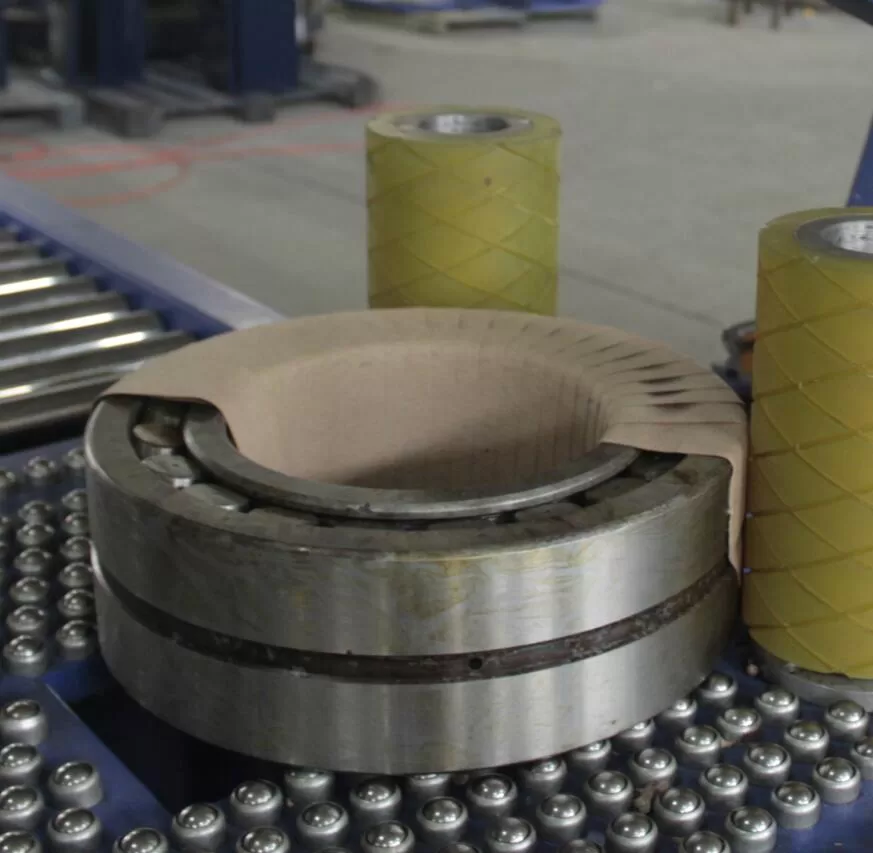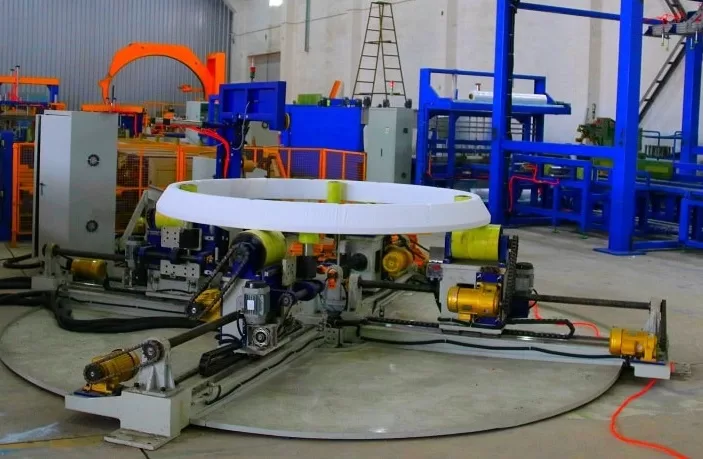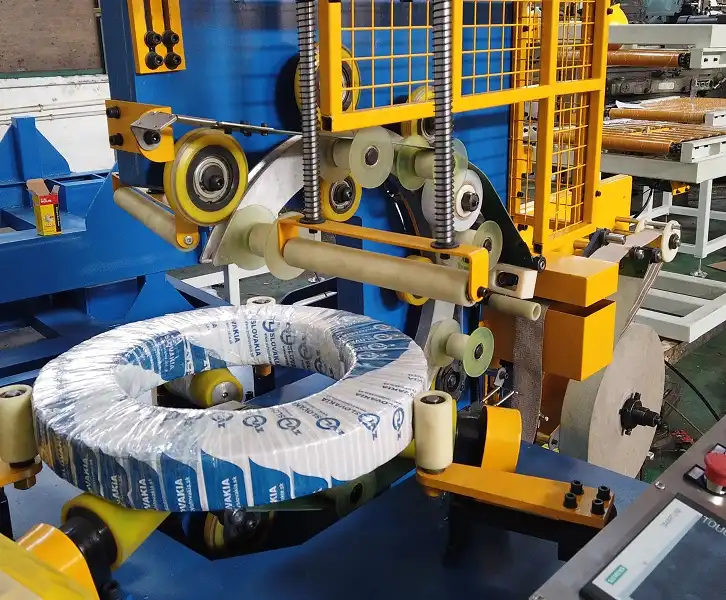How Does a Bearing Packing and Wrapping Machine Boost Efficiency in Modern Manufacturing?
I see production lines slow down because staff must pack and wrap delicate bearings. This task drains labor hours, raises error rates, and complicates shipping schedules.
Many managers ask how automated bearing packaging fixes these issues. It applies uniform film layers and guards each component against shock or moisture. That means fewer damaged bearings in transit. It also cuts labor demands, so staff can handle more specialized tasks.
I think this automation is a key upgrade. When every bearing is sealed with proper tension and coverage, risk of surface harm drops. Customers notice consistent product quality. Operators also avoid repetitive strain. Read on if you need to improve packaging speed, reduce errors, and keep bearings free from dust or friction.

What Are the Key Features That Make Automated Bearing Packaging Essential?
I often see manual packaging lead to overlooked flaws or insufficient wraps on bearings. Operators try to apply protective layers by hand, but they may leave edges exposed or misjudge tension.
Automated bearing packaging solves these pitfalls. It standardizes coverage through sensor controls and precision film application. That consistency fights corrosion and mechanical damage during shipment.
From my vantage point, these machines help manufacturers of all sizes. They adapt to various bearing diameters without constant retooling. The result is stable output, faster turnaround, and fewer returns or complaints.
Advancing Productivity with Accurate, Automated Wrapping
I remember facilities that once relied on hand-wrapping. Workers spent hours each day ensuring bearings were protected from dust, vibration, or moisture. It was tedious and prone to human error. If someone rushed, the film layers might be uneven. If tension was too tight, delicate bearing faces could suffer small dents. These factors created hidden issues that only appeared later in shipping or assembly.
Eliminating Manual Inconsistencies
Human operators have differing techniques or grip strengths. They also get tired. Over a long shift, tension might relax, or coverage might vary. An automated bearing packing machine fixes that. It uses rollers or rotating arms to apply film at the correct force. Some systems measure bearing diameter. Others rely on preset programs. In each method, the machine ensures layers are uniform. The operator only checks the feed spool or basic alignment.
Customized Film Tension and Material
Some bearings need strong film, especially large ones used in heavy equipment. Others need a softer or anticorrosive wrap for specialized lubricants. Automated packing allows easy switching between film types. The tension controllers let you calibrate for each specification. This fine-tuning helps maintain each bearing’s shape and surface finish. Thinner film might be enough for small bearings, while thicker wraps suit industrial sizes. Selecting the right film also controls cost.
Protecting Surfaces from Abrasion
Bearing surfaces have tight tolerances. A single scratch or dent can degrade performance. Automated machines wrap bearings carefully without excessive friction. Some designs include supporting rollers or padded grips that keep bearings centered. They avoid dragging them on rough surfaces. Tension sensors keep the film from cutting into sharp edges or corners. This systematic approach reduces micro-scratches that might remain hidden but cause problems in the field.
Reducing Rework and Returns
When I see a well-implemented bearing wrapping line, the number of returns or warranty claims falls. Bearings arrive in prime condition. Clients trust that each piece is sealed against dust or moisture. That trust can lead to repeat business.

Adapting to Different Sizes and Shapes
Bearings come in many diameters or thicknesses. Some are slim. Others are bulky. Manual packaging often requires new jigs or tools for each size. Automated machines can adjust clamp width or film carriage height automatically.
| Key Feature | Advantage | Outcome |
|---|---|---|
| Sensor-Based Film Control | Applies precise tension for uniform coverage | No overstretch, no weak wraps |
| Quick-Change Options | Switches film rolls or clamps fast | Minimal downtime, multiple bearing sizes handled |
| Robust Support Mechanisms | Centers bearings without rough contact | Fewer surface marks, stable alignment |
| Custom Film Materials | Matches wrap strength to bearing needs | Saves cost, prevents overwrapping |
| Automated Cycle Monitoring | Detects alignment or tension errors early | Less rework, consistent daily output |
Integration with Upstream and Downstream Operations
An automated packing unit can fit into a broader production chain. Bearings might exit a machining station and enter the wrapper seamlessly. After wrapping, they might move to inspection or boxing. These continuous flows cut manual handling.

Boosting Workforce Efficiency
Manual packaging ties up staff with repetitive tasks. That leads to fatigue, possible injuries, and rising labor costs. Automated solutions let staff oversee multiple lines or handle more specialized duties.
How Does Proper Wrapping Prevent Damage and Reduce Material Waste?
I have observed how small packaging mistakes cause big financial hits. Bearings that rattle inside loose film degrade or gather dust. Over-tight wrappings can deform seals or mar surfaces.
Proper wrapping alleviates these risks by regulating tension and coverage. That also optimizes film usage.
Finding the Balance Between Secure and Efficient Packaging
I recall chaotic shipping departments where staff used guesswork. They either wrapped multiple times to feel safe or left corners exposed. Automated wrapping sets a sweet spot.
Controlling Tension to Shield Delicate Parts
Bearings have precise tolerances. Overly tight film can press sealing rings against rolling elements. Automated wrappers measure tension. They keep it within safe limits.
Preventing Dust and Moisture Intrusion
Dust is a bearing’s enemy. Fine particles can lodge between rolling elements. Moisture causes rust or corrosion. Proper wrapping seals out these threats.
Reducing Film Overuse
Factories often buy extra film rolls because staff tear large sections to ensure coverage. Automated lines keep track of how much film is dispensed and optimize usage.
Fewer Handling Steps
Manual wrapping involves picking up each bearing, applying film, taping edges, and placing it back. Automated flow reduces these transfers.
| Common Damage Mechanism | How Proper Wrapping Helps | Advantage |
|---|---|---|
| Excess Tension | Maintains safe pressure around bearing seals | Prevents deformities or scratched faces |
| Dust Infiltration | Seals edges with uniform film coverage | Blocks grit that harms rolling elements |
| Moisture Exposure | Forms moisture barrier with protective film | Minimizes rust or corrosion |
| Handling Errors | Limits manual touches and potential drops | Cuts surface wear, preserves quality |
| Overuse of Film | Calculates exact wrap length, prevents oversizing | Saves material cost, lowers scrap |

What Should You Look For When Selecting the Right Machine Configuration?
I watched colleagues choose a wrapping system that only handled one bearing size. They realized too late it could not manage broader demands.
You must check load capacity, adjustable tension, film compatibility, and integration potential.
Planning a Future-Proof Packaging Line
I recall touring a plant that produced bearings for automotive, aerospace, and industrial clients. The chosen wrapper had modular stations that saved them from buying separate lines.
Capacity for Varied Sizes and Weights
Start by listing your bearing diameters, thicknesses, and weights. A machine must support these ranges. Flexible clamp mechanisms can keep pace with changing demands.
Tension Control and Film Range
Look at whether you need thick film for large bearings or thin film for small ones. Confirm your target machine can handle both.
Integration with Production Flow
Bearings often move from finishing or lubrication stations to packaging. Then they go to labeling or inspection. Minimal handling is ideal.
| Configuration Factor | Why It Matters | Benefit |
|---|---|---|
| Load and Size Capacity | Handles all bearing shapes and weights | Reduces need for multiple machines |
| Tension Adjustability | Adapts film force for large or delicate bearings | Prevents damage, ensures stable coverage |
| Film Compatibility | Works with multiple film gauges or specialized types | Extends packaging options |
| Conveyor or Robot Integration | Creates a seamless production flow | Lowers manual handling, cuts lead times |
| Maintenance Support | Eases part replacements and updates | Minimizes downtime, ensures longevity |

Ease of Maintenance and Spare Parts
A machine with accessible panels and modular parts is quicker to fix. Confirm that the manufacturer stocks common parts or has local service partners.
Operator Training and UI
Look for a user-friendly touchscreen or simple control panel. Operators should easily set tension, film length, or wrap speed.
Future Expansion
If you foresee expansions, choose a machine that can handle bigger bearings or run faster cycles with minimal hardware changes.
Budget vs. ROI
Weigh total cost of ownership instead of just sticker cost. Advanced tension control and pre-stretch features reduce film usage.
Testing and Pilot Runs
If possible, run sample bearings through a demo unit. Watch how it handles edges or potential misalignments.
Conclusion
I have watched how an automated bearing packing and wrapping machine transforms daily operations. It applies uniform tension, keeps out contaminants, and saves film. It also frees staff from repetitive wrapping chores.
In my time at FHOPEPACK, I realized that success relies on matching a machine’s configuration with your bearing range and workflow. A well-chosen system will adapt as new product lines emerge. This investment protects bearings, boosts speed, and pleases clients who rely on pristine components every time.